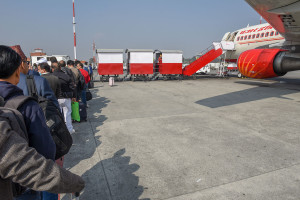Money
Nepal has enormous biomass potential, research shows
By converting waste biomass, the country can produce 1.7 to 5 million tonnes of pellet or briquette and biochar.
Sangam Prasain
Nepal has huge waste potential for biomass, a resource that can significantly boost the economy if correctly managed and valorised, according to a new research paper.
Harnessing waste biomass could cut the country’s carbon dioxide (CO2) emissions by up to 52 percent and meet up to 12 percent of current energy consumption, according to the paper entitled ‘Possibilities and challenges for converting waste biomass into fuel, feed, and fertiliser in Nepal’.
Most of Nepal’s waste biomass is used conventionally, such as for kitchen fuel and animal feed, without proper valorisation.
This is a pressing issue as open dumping and burning, particularly of municipal waste, is a common practice in Nepal, according to the paper, with detrimental effects on the overall ecosystem.
“Our study estimates the potential of about 89 million tonnes of waste biomass annually in Nepal, mainly from the agriculture, municipal, livestock, fowl, and human sectors,” said Sagar Kafle, assistant professor at the Institute of Engineering, Tribhuvan University.
“We have revealed the potential at the sub-national level in Nepal, highlighting its possibilities and challenges for converting the fuel, feed, and fertilisers,” said Kafle, who is currently pursuing PhD at Auburn University, US.
The paper estimates that through the conversion of waste biomass, Nepal can produce about 1.7 to 5.0 million tonnes of pellet or briquette and biochar, 1.7 to 5.1 million tonnes of feed block, 129 to 387 million cubic metres of biogas, and 0.6 to 1.9 million tonnes of fertiliser.
“These valuable products can have significant environmental and economic benefits,” the paper said.
Waste biomass is generated from different sources, such as forestry residue, agriculture crop residue, municipal organic waste, and livestock waste. Improper management of such residue and waste negatively impacts overall biodiversity, a growing global concern.
For example, the poor handling and management of municipal solid waste, mainly generated from the urban sector, pollutes the surroundings and impacts overall biodiversity, including human health. Its management is one of the significant challenges for the relevant authorities, as it needs resources.
Municipal solid waste, comprising more than half of organic waste in developing countries, is being dumped and burned openly in Nepal.
Similarly, open burning of crop residues, especially paddy straw, is practised in Nepal, resulting in air pollution. This practice is particularly prominent in the Tarai, where combined harvesters scatter straw across the fields, making collection impractical.
Farmers often burn the straw as they find it economically unviable to collect and meet the next cropping season.
Livestock manures generate methane during decomposition, contributing to global warming. However, anaerobic digestion technology could trap and utilise this gas as energy.
Also, improper management of human waste—urine and faeces—pollutes soil and groundwater, affecting human health.
Although the country has declared itself free from open defecation, dumping raw sewage and septic tank waste into rivers is common in Nepal.
Due to the lack of proper conversion knowledge and technology and the unavailability of status data, the waste biomass is improperly managed or conventionally used in many developing countries.
The conventional use of waste biomass is less efficient, hazardous to the environment, and does not generate economic growth. For example, using dry dung cake instead of biogas for cooking fuel is less efficient, degrades indoor air quality, and impacts human health. The lack of data generation, consumption, and availability hinders policymaking and planning for the biomass-based industry.
Some houses also have toilets connected to biogas plants. In the fiscal year 2020-21 alone, about 3,975 biogas plants were installed in Nepal. This shows that waste biomass is utilised in modern ways, such as producing biogas. However, the majority is still untapped and is conventionally used or managed poorly.
Proper utilisation of such waste biomass needs quantification at the subnational level, which will help develop innovative industries for sustainable development, such as by enhancing the local economy, creating jobs and increasing the share of renewable energy.
The study’s findings are significant and show enormous waste potential in the Tarai, especially in Morang district of Koshi Province.
Prof Sushil Adhikari, co-author of the study and professor at Auburn University, highlighted the opportunities for producing fuel, feed, and fertilisers from such waste biomass.
“The pellets and briquettes produced from waste biomass could effectively replace coal in thermal power industries such as brick and cement. It can reduce the country’s carbon dioxide emissions by up to 52 percent and meet up to 12 percent of current energy consumption.”
He elaborated on the benefits of producing a densified total mixed ration using crop residue. “In Nepal, where mass transport systems are lacking, and transport costs are high, such densified feed blocks could be a game changer in feed industries.”
Further, biogas from waste biomass could reduce the dependency on imported LPG fuel and produce nutrient-rich fertilisers as by-products.
“The country lacks location-specific data on the potential and availability of waste biomass, which is important for planning waste-based industries,” said Prajal Pradhan, the co-author of the study and assistant professor at the University of Groningen, the Netherlands.
Pradhan highlighted lack of mass transport infrastructures and networks and the challenges due to the topography and terrain, which create difficulties in transporting raw materials and final products.
“Uncertainty in investment and market, insufficient management regulations and policies, and poor intersectoral coordination are added problems. These challenges need to be addressed to promote waste biomass-based industries in Nepal,” said Pradhan.




 8.12°C Kathmandu
8.12°C Kathmandu















